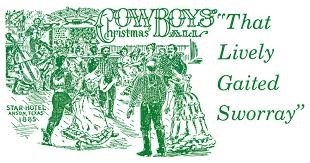
(Southwestcollection.wordpress.com)
Ranch life was a solitary, lonely life for both ranchers and hired hands. But at Christmas time, everyone gathered for a little fun. In Jones County, the ranchers, cowboys and families made the way to the annual Christmas Dance held at the Star Hotel.
The Star held the free dance every year to show appreciation for their patronage. In the 1880s, one didn’t drive around the corner for a bottle of milk. Any and everything needed was either made on the ranch or seldom bought in Anson. All business was handled in the county courthouse at Anson. And going to Anson was not a short trip. Men and their families usually made an overnight trip and stayed at the Star.
Everyone came to the ball, everyone from old “stove-up” cowhands to little children. Dancing lasted well into the night, sometimes greeting the rising sun. The dances included square dances, schottische, heel and toe polka, waltzes, and the Virginia reel. Music was usually provided by a local band consisting of a bass viol, a tambourine and two fiddles. Other dances had only fiddle players. Instruments hidden in pockets or tied to a saddle horn were most popular. I suspect that the bass viol stayed at the hotel for such events. Instruments like harmonicas and mouth harps were quite popular.
In 1890 the Star Hotel burned to the ground, taking the Christmas Ball with it. But in the Great Depression of the 1930s citizens revived the Ball under the name Cowboys’ Christmas Ball. Leonora Barret, Anson teacher and folklorist, put the event together in the high school gymnasium. People were still around who remembered the dance steps and old customs. Men bowed and women curtsied. With slow music the dancers performed in an unhurried manner and with as much grace as found in the late 19th century.
In 1937 the group accepted an invitation to the National Folk Festival in Chicago. Since no other dance group performed such dances, other invitations came until the beginning of World War II. In 1938 Eleanor Roosevelt invited them to dance on the White House lawn. In 1940 the Anson group, now incorporated, built Pioneer Hall as a permanent home for the Cowboys’ Christmas Ball.
Anson’s Cowboys’ Christmas Ball caught the attention of several folklorist. During the Depression, those enthusiasts could be found among chuck wagons, along levees and railroads, and in saloons, churches, and penitentiaries throughout the south and southwest. The folklorists developed a method to record the music for posterity. At a time when money was almost nonexistent, folk songs filled a need to forget troubles and enjoy their own type of music.
In some areas of the south tenant farmers gathered on the front porch every Saturday night. Their music was more blues than the cowboy ballads. Much of that genre became part of the Louisiana Hayride. It was these folklorists who played a central role in recording, preserving and promoting American folk music.
